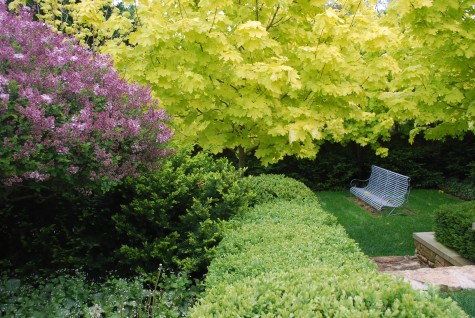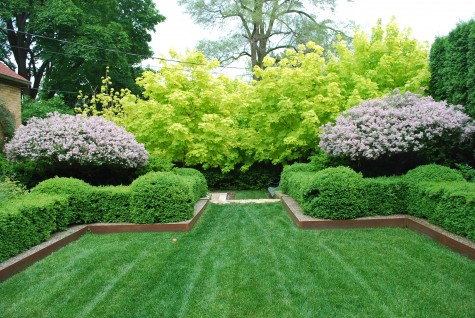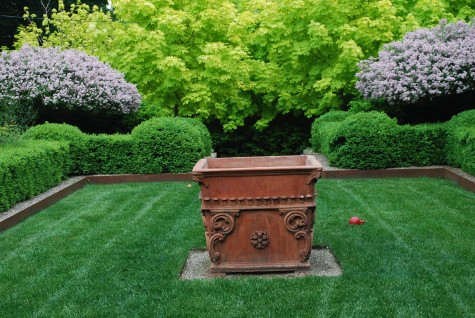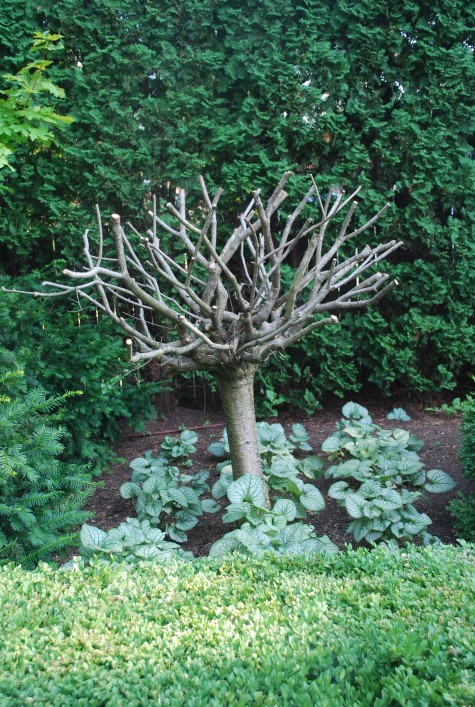
I am sure I have written before on the subject of pollarding. Pollarding refers to the practice of cutting back the branches of a tree to within close proximity of the main trunk. Pollarding originally had much to do with practicality-home fireplaces needed wood to burn-for cooking, and for heat. Americans are used to the sea from shining sea-endless land. In Europe, space was precious. Fuel-even more precious. Cutting trees back to their main trunks for firewood was not an aesthetic decision-it was a life decision. In many European countries, pollarded trees enabled large growing trees to thrive in small spaces, along narrow streets. American gardeners are not used to seeing this type of pruning as our country is vast. There is rarely need for any American gardener to cut trees back this hard.
 My Palabin lilacs on standard were in place when I bought my house some fifteen years ago. For the first nine years I lived here, I did nothing to the landscape, save planting some 6 foot arborvitaes and in one moment of garden angst, 100 Hicks yews. The Palabin lilacs on standard kept growing, despite my neglect.
My Palabin lilacs on standard were in place when I bought my house some fifteen years ago. For the first nine years I lived here, I did nothing to the landscape, save planting some 6 foot arborvitaes and in one moment of garden angst, 100 Hicks yews. The Palabin lilacs on standard kept growing, despite my neglect.
 Not that I minded their growing. Every year they put on a show of pale grey violet blooms that made my heart pound. When they are in season, they are dramatically in season. I plant Palabin lilacs regularly; they deliver much, and ask for little. But having planted a slew of boxwoods, and 11 Princeton Gold maples, the available space for the lilacs-diminishing.
Not that I minded their growing. Every year they put on a show of pale grey violet blooms that made my heart pound. When they are in season, they are dramatically in season. I plant Palabin lilacs regularly; they deliver much, and ask for little. But having planted a slew of boxwoods, and 11 Princeton Gold maples, the available space for the lilacs-diminishing.

In recent years, I have pruned after their bloom, pruned again-and pruned more. I wanted a low oval profile-not a ball shape. In retrospect, I realize that I was bold in my mind, but timid in my pruning. I posted about pollarded trees, and these lilacs some time ago. A reader encouraged me to go ahead and cut them back; he was quite sure I needed a push. He was right-I needed a push.
 The better part of two weeks ago, I cut these old Palabins back hard. I have not heard one word from them, to date. I am sure they are shocked, outraged, and disgusted with me. I have not seen one bud push forth on these giant stems. The jury is still out-no doubt. Some times I am spot on with aesthetic decisions, to the betterment my entire property. Other moves I make that are dicey-all I can do now is wait. Should you wonder if I am chewing my nails-pretty much. Should they decide to leaf out around these thick old branches, I will be thrilled.
The better part of two weeks ago, I cut these old Palabins back hard. I have not heard one word from them, to date. I am sure they are shocked, outraged, and disgusted with me. I have not seen one bud push forth on these giant stems. The jury is still out-no doubt. Some times I am spot on with aesthetic decisions, to the betterment my entire property. Other moves I make that are dicey-all I can do now is wait. Should you wonder if I am chewing my nails-pretty much. Should they decide to leaf out around these thick old branches, I will be thrilled.
Oh the torture! I couldn’t even muster the strength or courage to do that. I’m 18 years younger that you are so maybe when I’m 60 I can do that!! My next door neighbor did that to her Miss Kim lilac tree. I was shocked and dismayed that she even did that drastic of a prune to her lilac tree. Rest assured, it came back next year looking great!
Dear Sheila, thank you so much for writing-I have felt terrible ever since I did the deed! Deborah
Deborah, I am currently in the same boat as you with my Miss Kim standard lilacs. I see these posts were back from July 2010. What happened? Did your lilacs survive the brutal pruning. I have three large standards that need to be under control. When I look at the what I would need to do, it would pretty much look like pruned picture above. It seems drastic. But did your lilacs live through the beating? How did they come back?
Dear Jerry, it took 2 years, but they came roaring back. They look great now. I hard pruner after they bloomed, in the spring. Just plan to devote a good amount of time to the recovery.Good luck to you! Deborah
Thank you. That is great to know. Guess what I will be doing tomorrow?
Jerry, you aren’t concerned it is too late in the season to do this? Most shrubs are starting to slow down in August. That hard pruning will be quite a jolt. Deborah
You make a good point. We are in zone 4 – Mpls, MN. When would recommend such a hard pruning? I would hate to kill them. Your advice is greatly appreciated.
Dear Jerry, prune in the spring, right after they bloom. Thanks, Deborah
Will do. Thank you. Once they are pruned back, do I do anything special? Give them lots of water? Fertilize them? Or just treat them like a normally do – nothing special?
water, food, and love-they will need it. Best to you, Deborah
Once you pollard, you’ll never go back to shaggy full sized tree stealing sunlight and endangering properties in high winds! The American prejudice against the practice is deep but absurd. American suburban gardens these days are every bit as small as those in Britain where pollarding is considered essential for property management.